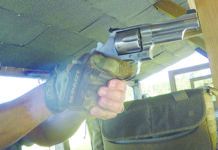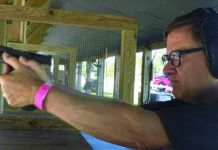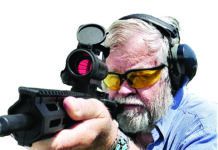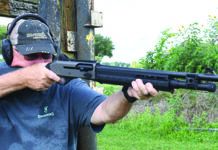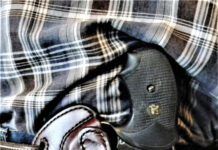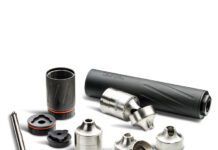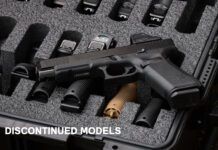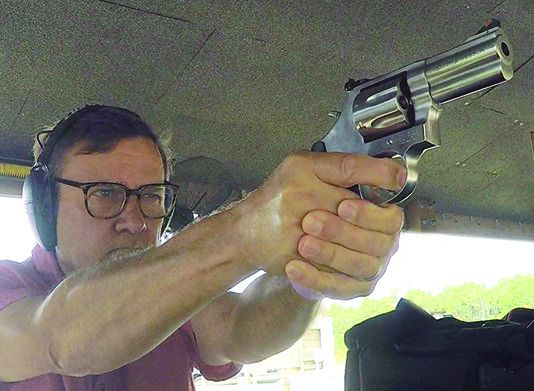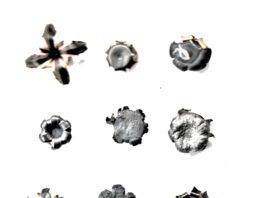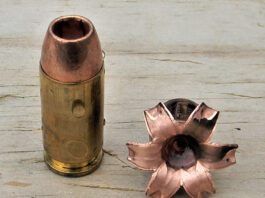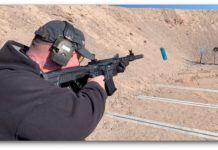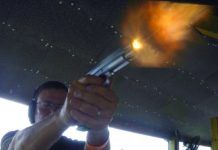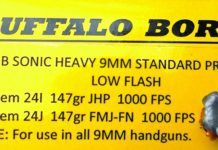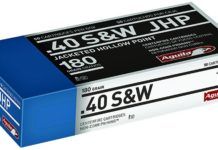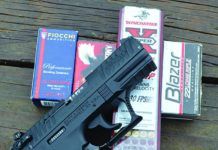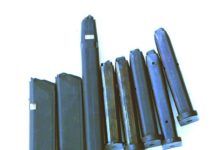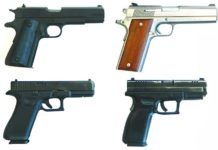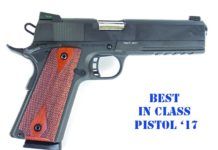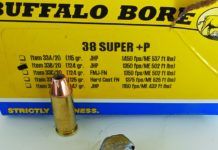SHOT Show 2019: Shotguns, Ammo, Compact Pistols, and Aftermarket AR Trigger
At SHOT 2019, Gun Tests Editor Todd Woodard rustled up some interesting products that are beginning to appear this spring. Here's a quick look at new self-defense ammo from Browning and Winchester, a new shotgun from Armscor, new compact pistols in 9mm and 380 ACP from Springfield Armory, and a new drop-in trigger for your favorite AR-15 from American Tactical.
2018 Guns & Gear Top Picks: Firearms
Deep-Penetrating Heavy-Bullet 9mm Loads: Pretty Good Picks
The 9mm Luger cartridge is the most popular handgun centerfire round in the market today. It's easy to understand why: The 9mm is a powerful number with high velocity and good accuracy potential, and it can offer deep penetration with the proper loads. Also, the 9mm is controllable in compact handguns by shooters with modest experience, and many very experienced shooters favor the 9mm as well. At the same time, the 9mm has a well-documented string of failures with non-expanding loads and loads lacking sufficient velocity and energy to ensure penetration. This just proves all jacketed-hollow-point bullets are not created equal, and too little penetration may not stop an assailant. The ideal load should have a balance of expansion and penetration. The 147-grain 9mm has been criticized by some for lacking expansion potential. The 147-grain load originally was designed to meet FBI requirements for deep penetration and barrier penetration. Expansion was modest. Many 147-grain loads still meet this criteria, while others demonstrate greater expansion. A new choice is the 135-grain bullet weight. This projectile is designed to provide greater velocity than the 147-grain JHP while offering greater penetration than the popular 124-grain expanding bullet.
We tested two 135-grain loads along with ten 147-grain JHP loads and a single 150-grain JHP as well as a heavyweight 165-grain combination. For those living in a true four-season climate that find themselves likely to face heavily bundled adversaries, these loads offer optimal performance. Anyone needing penetration against light cover might consider these loads. A follow-up question would be are they the best choice for personal defense? We believe that some of the 147-grain loads provide a good choice for personal-defense use compared to light-bullet loads with less expansion. The HST, as an example, offers excellent expansion and deep penetration in water.
We used a new Glock 19X as a test gun. The barrel length at about 4 inches is a compromise between service pistols and subcompact handguns. We fired three cartridges of each load to average expansion and penetration in water. We also fired three five-shot groups for accuracy at 25 yards. The remaining rounds were fired for function testing. During the test, there were no function problems of any type. Accuracy was likewise good in every case, with some loads being more accurate than others.
New Handguns and Ammo for 2018
Gun Tests reporters and editors on the scene at SHOT Show 2018 in Las Vegas scoured the show for new pistol and handgun accessory entries for our readers to consider this year. Amazingly, a handgun made of steel with a design more than 100 years old — the fabled 1911 — still drives the market. A third of the new guns that follow are based on this legendary platform, followed closely by pocket pistols, and it's clear the revolver is not the antiquated firearm many assume. In fact, when it comes to handguns, 2018 is a good mix of old, new, plastic, and steel, with a wheelgun or two thrown in for good measure, along with loads for defensive handgun use to feed these new beasts. Here's a rundown on a few new handgun and ammunition choices for 2018 that our staff thought were notable and which we'll be looking to include in future issues.
Bad Luck with Ammunition
Hey Gun Tests, just finished reading the April issue. Another great issue. One thing I wanted to point out was the affordable ammo tests. I personally love those kinds of tests. It also shows me that I am in the minority on the Remington Thunderbolt 22 LR ammo. I've bought a few boxes of that stuff throughout the years and it hasn't performed that well in any of my 22s. I'm the customer that gets the boxes with the duds in them. Or the bullets that do not cycle the gun at all. CCI Blazer is my affordable 22 ammo of choice. Shoots quite well in my rimfires. I also loved the home-defense section, too. Keep that kind of test coming as well. Thanks for making the best firearms magazine out there.
224 Valkyrie Cartridge Specifications Approved
Affordable Handgun Ammo: Is It Up to Par for Your Firearms Use?
A few months ago we received an insightful comment from a reader. He asked us to do an ammunition comparison on inexpensive loads from diverse makers. How do they perform, he asked, compared to the big three (Federal, Remington, and Winchester) and the well-known Black Hills, Hornady, and Speer, and a few more. We are lucky to have so many choices, and because most, if not all, manufacturers subscribe to SAAMI standards, the ammunition should be safe and reliable.
There are two aspects to reliability: feeding and chambering properly and then going bang. We have run across poor ammunition that fail on either or both counts, but most of it is surplus ammunition from third-world nations. We won't discuss it here. If a brand makes it to the national market, the product has some merit.
There are economy loads that offer jacketed hollowpoint (JHP) bullets, and most of these do not have the development behind them that the Big Three loads do. However, we did test some JHP loadings in this report because they were as inexpensive as any other loads, and, in some cases, were all that was available. The goal of this report was to fire as many types of ammunition as possible in both popular and less popular calibers and determine if we were getting our money's worth in practice ammunition.
Safety came first, then reliable function. We also paid attention to powder burn. We have had experience with foreign-produced ammunition that simply did not have the powder technology of our domestic loads and the result was a lot of powder ash. If a load was particularly dirty — lots of smoke and debris — we took that into account.
Thankfully, the recent ammunition shortage that now seems to have abated had us searching out and trying anything we could find. Brand loyalty took a hit. So it is good to know if these inexpensive loads will function and if they are accurate enough for practice. Some of us like to fire for accuracy at longer ranges, but nothing tested wasn't accurate enough for practice at 15 to 25 yards. Some of the loads tested are among the very few available in certain calibers. There isn't a broad choice in 32 Smith & Wesson Long and 38 Smith & Wesson, as two examples.
It is worth noting that one of the raters has different criteria for loads, and they are reliability, dirtiness, and speed. His old Colt will not feed hollowpoints, so he concentrates on finding reliable rounds, getting a clean burn, and generating velocity, goals that are worthwhile to pursue.
As we told the reader who asked for this test, in our gun evaluations we strive to be fair and present a level playing field. That is why we use proven ammunition when testing a new gun. We generally include a generic ball load and one or two defense loads from the major makers when testing a new gun. This is only fair. Testing an unknown load with a new gun may not prove anything — does the ammunition or the gun bear the responsibility for failures? As one of our raters noted in his work at our sister publication, the well-respected American Gunsmith, and as a private gun fixer, he keeps a supply of generic ball from Federal, Fiocchi, Black Hills, Speer, and Winchester on hand. The gun is sick if it doesn't feed these loads. By the same token, when testing the ammunition in this report, we did not pick up new guns, but instead relied on proven firearms from our team's collections that have proven reliable and reasonably accurate.
We were able to collect loads in thirteen calibers for use in this feature. During the test, our shooters used a Bullshooters pistol rest to confirm accuracy. Some of the results were excellent, others poor, and most fair. Accuracy is relative, and the 38-caliber Iver Johnson break-top would not be in same accuracy range as a tuned 45 ACP or 9mm pistol, but we expected some type of pattern.
One note about these burner loads: Brand performance isn't always consistent among the makers of inexpensive ammunition. One maker may have a poor load in one caliber and a standout in another. Let the buyer beware, but we found good loads for practice in most cases. We fired at least 50 rounds of each load tested, including 35 rounds off hand and three five-shot accuracy groups. Accuracy testing was conducted at a distance appropriate for the handgun.
In each case, we describe the performance of the test rounds, but we highlight one round in particular that we recommend.
Non-1911 Magazines: We Test A Passel of Them Head to Head
You can never have enough magazines. Modern pistol shooters practice hard; compete in IDPA, IPSC, and Three Gun matches. They need reliable equipment. Personal-defense shooters need reliable, functional magazines at a fair price. In this installment, we are testing magazines for fit, function, reliability and durability. In common with recoil, striker, and hammer springs, magazines should be replaced from time to time. While new springs may help magazines retain some function, there is a time when cracked or bent feed lips demand the magazine be discarded.
In this test, we followed the same criteria we used in testing 1911 magazines, except this test was more diverse in both handguns and cartridges. The handguns used in the test were proven examples, with few function exceptions. Since the firearms had long-ago proven reliable, there would be no confusion as to which part was responsible for the malfunction, the pistol or the magazine. We also used good-quality ammunition to test the magazines. In each case, we used at least two magazines of each type to bang on.
Using proven criteria and a team of experienced raters, we learned some magazines were durable and service grade; that is, we would be comfortable putting them into "service" in critical situations. We also learned others were okay for range use, but not critical use. In all of these cases, we recommend spending a little more for service-grade magazines across the board for all uses. We don't think it's advisable to mix low performers with high performers in this critical area of function.
Hot Handguns and Cartridges From Springfield, Coonan, Glock
For more than a year, we have been testing and evaluating some of the most powerful and interesting self-loading handgun cartridges. These are the ubiquitous 9mm Luger, which we think has become the baseline against which all other handgun chamberings can be compared, and the far-less-common but still commercially viable 38 Super, 357 SIG, and 357 Magnum, the last of which is chambered in a Coonan handgun. The evaluation was the result of a reader request, and three of which, the 9mm, 38 Super, and 357 SIG, sometimes use the same bullets, but at different velocities.
We began with a number of goals. First, as always, reliability has to be foremost because the handguns were competing as personal-defense choices. We also viewed them as outdoors-carry choices for defense against feral dogs and big cats. We wanted to see how efficiently each cartridge delivered its power, with the idea that the 9mm set the floor. Increased flash, blast, and recoil may be counterproductive in the others, and as it turned out, we got more horsepower with less recoil than expected. The energy difference wasn't incremental; it was profound. We didn't choose average 9mm or 38 Super loads, but instead picked those loads that had given good results in the past. Only the top performers in 9mm and 38 Super are in this report. With the 357 SIG and 357 Magnum, we were on new ground and chose a representative sample of bullet weights. The 357 SIG and 357 Magnum enjoy an excellent reputation for terminal ballistics. The 9mm, less so, and based on previous data, we expected the 38 Super to be as effective or more than a 9mm Luger +P+ load. The primary consideration was personal defense, so control was important. The larger guns may not be ideal for concealed carry, but would be good handguns for field use or home defense. For those wishing to deploy a handgun with plenty of power and accuracy, the 357-caliber self-loaders are easier to control than Magnum revolvers. The self-loaders demonstrate less recoil due to the smaller charge of faster-burning powder and the movement of the action and compression of springs as the handgun is fired. So how would they compare to the revolver? As it turned out, these modern powerhouses outclass the 357 Magnum revolver, in our opinion, on many levels.
We collected a good supply of ammunition, five loads for each gun versus our usual three. We chose three powerful hollowpoint loads for accuracy testing, as is SOP for Gun Tests. We added a fourth load for ballistic testing to test penetration and expansion. We added an economical practice load for use in the combat-firing test phase. So, this was a thorough test requiring several months. We elected not to go lighter than 115-grain bullets in any chambering. The 357 SIG, 38 Super, and 9mm Luger are usually loaded with bullets in the range of 115 to 147 grains. We fired 125-, 140-, and 158-grain bullets in the 357 Magnum Coonan. Here are the results.
2017 Guns & Gear Top Picks
Toward the end of each year, I survey the work R.K. Campbell, Roger Eckstine, Austin Miller, Robert Sadowski, David Tannahill, Tracey Taylor, John Taylor, and Ralph Winingham have done in Gun Tests, with an eye toward selecting guns, accessories, and ammunition the magazine's testers have endorsed. From these evaluations I pick the best from a full year's worth of tests and distill recommendations for readers, who often use them as shopping guides. These choices are a mixture of our original tests and other information I've compiled during the year. After we roll high-rated test products into long-term testing, I keep tabs on how those guns do, and if the firearms and accessories continue performing well, then I have confidence including them in this wrap-up.
38 Super Loads: We Like Buffalo Bores Jacketed HPs
The 38 Automatic Colt Pistol Super cartridge isn't our most popular handgun cartridge, but in the loyalty of a small following it is unique. The 38 ACP Super must be understood as to its potential. All modern loads are marked 38 ACP Super +P, but all loads are in the same pressure range of safety demanded by the SAAMI, despite very different performance. Many are loaded below the potential of the cartridge. The 38 ACP, introduced in 1900, is no longer in regular production. This is because the original 38 ACP, introduced in 1899, was later upgraded to the powerful 38 ACP Super. Though the cartridge-case dimensions are identical, the Super is the much hotter cartridge. Modern SAAMI standards called for the 38 Super to be labeled 38 ACP Super +P, which is confusing. While some of the modern loads are hotter than others, all are safe for a 38 ACP Super handgun in good condition. The old double-link Colt 38 ACP self loaders should never be fired with Super loads. The 38 Super was once a handloading proposition for maximum performance. Using 9mm JHP bullets and sometimes heavy hard-cast 38 Special lead bullets, handloaders upgraded the 38 Super. The 115-grain JHP was jolted to 1400 fps or beyond. Today Cor-Bon, Buffalo Bore, and Double Tap offer high-performance loads rivaling some of the hotter handloads of yore. The 38 Super may be enjoying an upsurge in popularity as both Federal Cartridge Company and SIG Sauer have introduced new JHP loads for it. We were able to find 12 personal-defense loads and four FMJ loads. For all the testing, we fired the rounds out of a Rock Island Armory 1911, a reliable and affordable 38 Super launchpad. It's a standard Government Model steel-frame pistol with 5-inch barrel.
First, we tested the full-metal-jacket loads for use in competition and general shooting. We recorded basic accuracy, velocity, and energy for these rounds, but as you'll see in the accompanying table, their widths, weights, and penetration readings are all the same. The FMJs didn't expand, didn't shed weight, and shot through our water-jug lineup, putting them at +24 inches, penetration beyond what we recommend for self-defense.
The Fiocchi 129-grain FMJ proved to be the most accurate by a margin, with a clean burn and excellent overall performance. It is the Best Buy for accuracy and economy. The SIG Sauer 125-grain FMJ loading was close behind the Fiocchi loading, with little real difference other than price. While the Prvi Partizan 130-grain FMJ was less expensive, it did not burn as cleanly nor was it as accurate. The Winchester 130-grain FMJ was the most expensive, and it was middle of the pack in terms of performance. Accordingly, we'd rate the Fiocchi as an A, the SIG an A-, the Prvi Partizan a B, and the Winchester a B-.
We looked for what we always look for in personal-defense loads. This is reliability first, then accuracy, a clean powder burn, and a good balance of penetration and expansion. We prefer a load that penetrates and expands over a load that fragments. In the 38 Super, there were loads that penetrated well but also fragmented, and we had to give them a passing grade based on penetration. The full-power 38 Super is similar to the 357 Magnum with 110- to 125-grain bullets, but the Super is much more controllable and has less muzzle blast and recoil. Relatively small charges of fast-burning powder create less recoil energy than larger charges of slow-burning powder. Even the fastest loads did not create muzzle flash and blast as sometimes seen with the 357 Magnum. The 38 Super isn't in the class with the 357 Magnum as far as heavy hunting loads, and the Magnum at its best will beat the 38 Super, but with factory defense loads, the two are comparable, with the 38 Super having the advantage in some cases. For your convenience, we have added the 357 Magnum results panel from earlier this year so you can compare the loads.
We were able to test three loads from Buffalo Bore. These included 115-, 124-, and 147-grain loads. All of these used the Hornady XTP bullet, a proven projectile for obtaining excellent penetration and expansion. These bullets were designed for the 9mm Luger, and things get interesting when the bullet is supercharged by 200 fps. As an example, one rater noted he was no enthusiast concerning the 147-grain load, but that was before it was tested. Here are the results round by round.




